संधिविग्रहयोस्तुल्यायां वृद्धौ संधिमुपेयात्।
[Translation: If there is an equal benefit in peace or war, he (the king) should choose peace.]
Amid the pandemic situation triggered by Wuhan virus aka COVID-19, the year 2021 witnessed the continuation of terrorist activities worldwide, linked directly or indirectly with different geopolitical events. In the current trends of violent extremism, emerging technologies empower extremists; therefore, we may expect a diversification and fragmentation in terrorism in the near future. The first part of the series— ‘Terrorism Studies-National’, covered terrorism-related incidents that took place in India, mainly in four areas— i) Jammu & Kashmir (J&K), ii) Left-Wing Extremism, iii) Islamic Extremism, and iv) Khalistan-inspired Extremism.[1] This write-up is the second and final part of the ‘Year-End Review’ series, highlighting both aspects of terrorism studies— political & religious, and presenting a forecast of how 2022 may look. In this write-up, the developments in terrorism studies have been categorised as per regions — a) America, b) Sub-Saharan Africa, c) West Asia, and d) South Asia (excluding India) and gives out the likely trends for 2022 in the conclusive section.
The Trends of 2021
Some significant geopolitical developments will have on impact global terrorism in the coming years. The year began with an attack on Capitol Hill as a violent protest against the US elections in late 2020. The Far-Right extremists who were Trump supporters and could not accept the victory of then-US president candidate Joe Biden against Donald Trump in the presidential elections of 2020 carried out the attack. In the middle of the year, another significant development that took everyone by surprise was the Taliban’s advances and capture of Kabul and the self-declaration of legitimate government— the Islamic Emirate of Afghanistan. According to the US-Taliban peace accord, US forces will completely withdraw from Afghanistan by September 2021. Taliban terrorists, on the other hand, advanced quickly and gained control of Kabul on 15 August 2021.
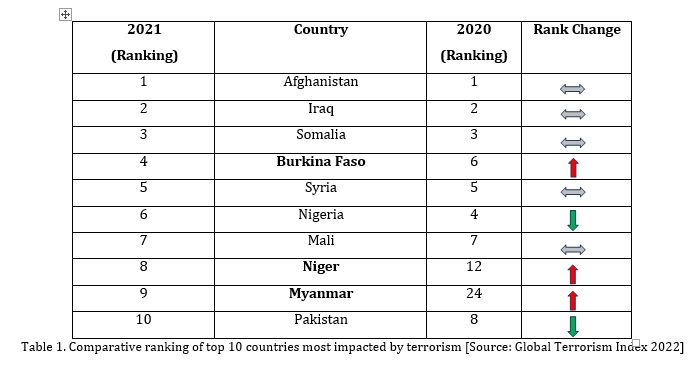
Table 1 shows the comparative ranking of 2020 and 2021 of the ‘top 10 countries most impacted by terrorism. The author referred to the Global Terrorism Index (GTI) 2022 report prepared by the Institute for Economics and Peace (IEP) — a Think-Tank based in Australia. However, it is pointed out there are a few flaws in the report, such as the fact that casualties caused by a military coup followed by protests (in the case of Myanmar) are counted as "deaths caused in the act of terrorism," resulting in a significant change in Myanmar's Global Terrorism Index ranking going up from 24th in 2020 to 09th in 2021. In the report, the top three positions remained unchanged— Afghanistan (rank 1), Iraq (rank 2), and Somalia (rank 3). Terrorism in Burkina Faso (rank 4) affected the neighbouring nations too— Mali (rank 7) and Niger (rank 8). The ranking of Iraq and Syria (rank 5) remained unchanged maybe because of the decline in the intensity of military conflict, followed by the collapse of the Islamic State’s (IS) so-called ‘caliphate’.
America
For more than two decades, the intelligence and security fraternity of the United States (US) has primarily focussed on countering Islamic extremism at home and abroad. The 9/11 terror attacks changed the thinking process and strategy to counter terror activities of transnational terrorist organisations— al-Qa’ida and Islamic State (IS) and their affiliated groups globally. In the name of the ‘Global War on Terror’ or GWoT, the US actively engaged in counter-terrorism (CT) operations in 80 countries on six continents.[2] Having a laser-focussed approach against Islamic extremism, the US administration and intelligence fraternity missed/ignored the rise of Far-Right extremism on its soil.
In America, the year 2021 began with unrest in one of the largest democratic nations in the world— the United States (US). The 2020 US Presidential election held on 03 November 2020 resulted in the victory of Democratic US presidential nominee Joe Biden and the Vice President nominee Kamala Harris against the incumbent Republican President Donald Trump.[3] For Republicans, the 2020 Presidential election results were unexpected and unfolded with the violent protests across the US, mainly in Washington D.C. On 05 January 2021, thousands of Donald Trump’s supporters gathered in Washington D.C. to support his false claims of stolen elections. The following day, on 06 January 2021, 2,000-2,500 Trump supporters attacked the Capitol building in Washington, D.C. The intentions were to overturn the election results by disrupting the joint session of Congress that assembled to count electoral votes furthering the process of President-elect Joe Biden’s victory.[4]
The Capitol Hill attack was orchestrated by the members of the Far-Right extremists, aka White Supremacist groups, such as QAnon, based in the US. The perpetrators assaulted law-enforcement officials, vandalised property and seized the building for hours. In the incident, five people were dead, and many were injured, including 138 police officers.[5] Similar to the modus operandi of Islamic extremist groups, the Far-Right extremist groups deploy an effective strategy that uses offline and online tools to disseminate their propaganda, plan and carry out their operations, and recruit new members.
Sub-Saharan Africa
The African continent is the world’s second-largest and second-most-populous after Asia. The continent contains 54 fully recognised nations and two de-facto states— i) Sahrawi Arab Democratic Republic and ii) Somaliland, with limited or no international recognition. Terrorism in Africa has evolved over a period during which several geopolitical incidents prepared the grounds for Islamic jihadi groups to prosper and carry out operations. The section will cover the significant developments in security scenarios in the Sub-Saharan Africa region.
In Sub-Saharan Africa, the Islamic terror groups carried out their operations in three major areas— a) Somalia, b) the Sahel region, and c) Chad and Nigeria. Terrorism in Somalia has created unrest for many years, expanding to Kenya, Mozambique, and the Democratic Republic of Congo (DRC). The Sahel region of West Africa, bordering Mali, Niger, and Burkina Faso, has also witnessed many terrorist attacks by Islamic jihadist groups. The Islamic State (IS) intended to expand and establish a stronghold in the Sahel region. In Mali, the political chaos, corruption, and weak-armed forces provide a friendly environment for the IS and other jihadist groups to prosper.
According to the Global Terrorism Index 2022 report, among the most terrorism-impacted countries globally, five countries— Somalia (ranked 3), Burkina Faso (ranked 4), Nigeria (ranked 6), Mali (ranked 7), and Niger (ranked 8), from Africa made it to the top 10 list.[6] On 21 March 2021, the Islamic State West Africa Province (ISWAP) terrorists carried out three coordinated attacks in the Tahoua region in Niger and killed 137 civilians.[7] The year 2021 was the first year in recent history in which Niger witnessed massive numbers of casualties in terrorist attacks perpetrated by the Islamic State in the Greater Sahara (ISGS) and Boko Haram almost every month of 2021.
Boko Haram, al-Shabaab, Jamaat Nasr al-Islam wal-Muslimin (JNIM), IS-affiliated— ISWAP & Islamic State in the Greater Sahara (ISGS) are the deadliest terrorist groups known for brutality in the region. After the ‘reportedly’ death of Boko Haram’s leader Abubakar Shekau in May 2021, followed by the subsequent defection of its operatives in favour of ISWAP, the fall of Boko Haram is very much likely. The ISWAP, affiliated with Islamic State (IS), overtook Boko Haram in Nigeria and its presence in neighbouring nations such as Mali, Cameroon, and Niger.
On the other hand, France has been heavily involved in Africa's counter-terrorism (CT) efforts. For the last seven years, France-led military operations, including Operation Barkhane, against the Islamic extremist groups, including al-Qa’ida and Islamic State in the Greater Sahara (ISGS), have been effective but not near the finishing point. According to the Global Terrorism Index 2022 report, terror groups, including JNIM, have exploited the political grievances, lack of economic opportunities, and other social conditions prevailing in the Sahel region.[8] The repetitive coups in the Sahel, mainly in Mali, do not promote stability in the region. In the last eight years, Mali faced three military coups (2012, 2021, and 2022), highlighting the government's incompetence to contain terrorism. Since the beginning of France’s CT operations, more than 100,000 West Africans have lost their lives, over a million were displaced, and the security forces of both— West African nations and France suffered heavy losses.[9]
Considering the loss of its troops, the cost of fighting against Islamic terror groups, and unpopularity among the Mali government and public, French President Emmanuel Macron, in February 2022, announced the withdrawal of French and allied troops from the country.[10] Consequently, Mali will suffer from France's withdrawal, and the security of neighbouring nations will be compromised.
West Asia
West Asia region has been in troubled waters because of several events, including the Israel-Palestinian conflict. Territorial disputes between Israel and Palestine led to frequent conflicts between Hamas/Palestinians and Israel Defence Forces (IDF). During Ramadan festive in April-May 2021, events such as Israel police barricading the Damascus Gate of the old city of Jerusalem and Palestinians' protests lay down the lines for conflict between Israel and Hamas. Between 10-11 May 2021 Hamas and another terror outfit— Palestine Islamic Jihad (PIJ), launched around 200 rockets, intercepted by Israel’s missile defence system— Iron Dome Ariel Defence System (IDADS).[11] The 11-day conflict ended with a truce on 21 May 2021, with many lives lost and property damage in Gaza and Israel.
Iraq remained in second place as ‘most impacted by terrorism in the Global Terrorism Index 2022 report. In 2021, around 833 terrorist attacks took place in Iraq, an increase of 33 per cent compared to the previous year (2020).[12] The rise in terrorist attacks contributed to the continued political instability used by terrorist groups, mainly IS, to their advantage. The Islamic State claimed responsibility for the worst incident of 2021, a blast at Al-Wuhailat market in Baghdad's Sadr city district on 19 July 2021, in which at least 36 people were killed and 60 more were injured.[13]
Islamic State and its affiliated terror groups based in West Asia exploit the tensions between Shia and Sunni sects of Islam religion, using Sunni alienation to seize and consolidate its control over areas of Iraq and Syria. With a similar approach in Iraq, IS has continued with low-level terrorist attacks in Syria. In light of the US withdrawal of forces from combat zones, IS will likely resume its activities at large scale to regain control of the area.
South Asia (excluding India)[14]
The territorial loss in Iraq and Syria gave Islamic State (IS) a straightforward way to expand towards Africa and South Asia through its affiliate groups and sympathisers. In May 2019, the IS had announced the establishment of Wilayah al-Hind and Wilayah Pakistan— two of its branches to carry out operations in India and Pakistan, respectively. However, IS gave no further details about the geographical extent of the newly created Wilayahs.
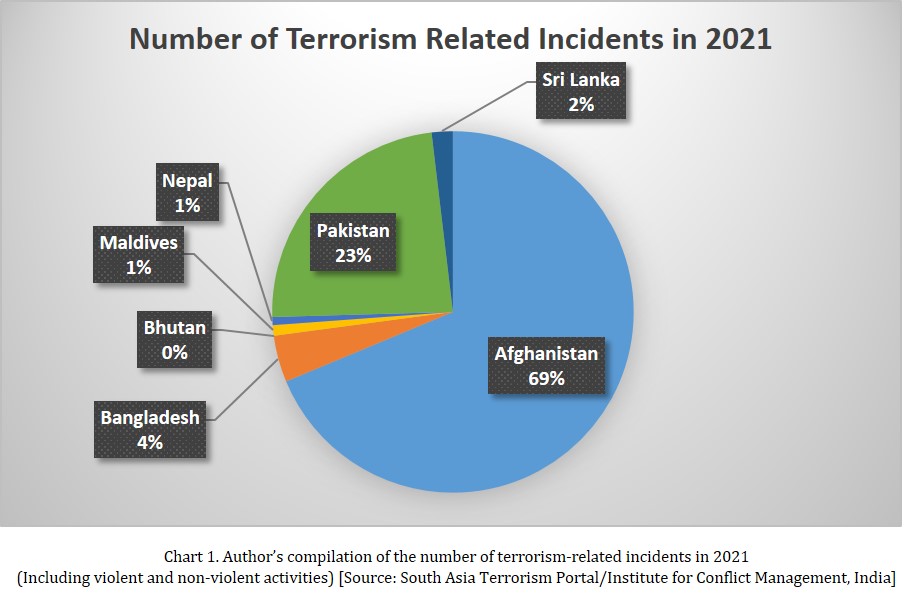
Despite fewer terrorist activities in the entire region, Afghanistan and Pakistan remained the most impacted nation by terrorism among other South Asian countries. In 2021, Afghanistan recorded 1,237 number of terrorism-related incidents (including violent and non-violent) as compared to 1,602 incidents in 2020. Whereas Pakistan recorded a rise with 424 terrorism-related incidents in 2021 compared to 319 incidents in 2020. Referring to Chart 1, Afghanistan and Pakistan recorded 92 per cent of the total number of incidents, followed by Bangladesh (04 per cent), Sri Lanka (02 per cent), Maldives and Nepal (01 per cent). Bhutan recorded zero terror activity since 2014.
In the Global Terrorism Index 2022, Afghanistan remained at rank 1 in the top ten countries most impacted by terrorism.[15] As declared in the so-called peace agreement between the US and the Taliban—Agreement for Bringing Peace to Afghanistan, signed in Doha, Qatar, the US announced the complete withdrawal of troops, including the NATO (North Atlantic Treaty Organisation) allied forces from Afghanistan by 01 September 2021; however, in unexpected and speedy operations, Taliban captured Kabul on 15 August 2021. As a part of the Taliban-Islamic State rivalry, on 26 August 2021, an Islamic State-Khurasan Province (IS-KP) suicide bomber— Abdul Rahman al-Logari, carried out a suicide bombing at Hamid Karzai International Airport, Kabul, and killed at least 182 people, including 169 Afghan nationals and 13 US service members.[16]
The conflict between the Taliban and IS-KP kept terrorist activities high in Afghanistan. Since 2015, IS-KP has continued its activities to establish a global caliphate while opposing the Taliban’s vision of having an Islamic Emirate with national boundaries. Keeping the ideology and operational approach in mind, one could only expect human rights violations, especially of women and children, and a further increase in Islamic extremism under Taliban-controlled Afghanistan.
According to the statistics in Chart 1, Pakistan accounted for 23 per cent of all terrorism-related occurrences in South Asia. In Pakistan, two terrorist groups— Tehrik-e-Taliban Pakistan (TTP) and Balochistan Liberation Army (BLA) claimed to be the most active terrorist groups in 2021. Based on the statistics collated from numerous news on terrorist attacks carried out by TTP and BLA against Pakistan security forces personnel, including police personnel; TTP carried out 17 terrorist assaults in 2021, killing 32 security forces personnel. The BLA carried out 13 attacks in the same year, killing 30 security forces personnel.
Post-2019 Easter Sunday suicide bombings in Sri Lanka, the country has tightened its counter-terrorism efforts to improve security through engagements with regional partners. In 2020-2021, Sri Lanka did not report any significant terrorist incidents. However, the IS-inspired attacks remained a threat to Sri Lanka.
Projections for 2022
The lockdowns or restrictions on freedom of movement or travel restrictions implemented during the COVID-19 pandemic may be the reason behind the decrease in terrorist acts in the United States and other parts of Europe. There is a significant probability of increasing terrorist activities if these restrictions are lifted in 2022, unless there is another lethal wave of COVID-19 cases worldwide. Post 06 January 2021, the QAnon group emerged as a threat to US national security. The QAnon’s conspiracy theories depict the government's failure on various social issues, including healthcare and the economy. As far as global rankings are concerned, Afghanistan may continue to lead the chart of ‘ten countries highly impacted by terrorism’ in 2022 as it led in 2021, followed by Iraq and Somalia.
Despite the Iraqi government’s declaration of IS’s military defeat in 2017, the threat has not disappeared from the region. IS continues to carry out low-level attacks in remote areas and deserted places in Iraq, to maintain the fear amongst the population. For security and stability maintenance in State, several African nations rely on foreign forces’ assistance, mainly the US. Amid the US withdrawal from Afghanistan, several jihadist groups celebrated the event as a victory for the Taliban. The strategic and ideological conflict between the Taliban and Islamic State-Khurasan Province (IS-KP) will continue with more attacks and civilian casualties. The Islamic terror groups, such as al-Shabaab in Somalia, and the JNIM in Mali, welcomed the Taliban’s capture of Kabul in August 2021.
The US administration announced the withdrawal of military support to the Somalian army fighting al-Shabaab, encouraging the terror group to make territorial gains. Al-Shabaab will use the reduction in counter-terrorism efforts as an opportunity to coordinate attacks that may result in political turbulence. Therefore, the withdrawal of foreign forces from Sub-Saharan Africa will likely give a golden opportunity to Islamic jihadist groups to expand and control vast territories, connect with global movements, and become a global threat. Continued conflict between government and jihadist groups will adversely affect the government's credibility and further create tensions among the public, resulting in chaos in a country.
Afghanistan's future is gloomy under Taliban rule. At present, the Taliban is failing to turn the promised dream of ‘good governance and a better future for Afghans’ into reality and continues building its armed units, such as the Badri 313 Battalion, Red unit, whose operatives are associated and trained by Haqqani Network— another terror network based in Afghanistan. The close nexus between Taliban and Pakistan-sponsored terror groups will project a security concern to the region, mainly Pakistan’s arch-rival— India.
On the important issue of Climate Change, the eco-activists’ approach to protest is non-violence; however, the inability and, to some extent, the unwillingness of government leaders may provoke these non-violent activists toward the conception of the eco-extremism or radical environmentalism. The eco-extremism would empower the re-emergence of environmental groups, like the Earth Liberation Front (ELF) aka Elves, which was one of the significant terrorist threats in the 1990s. According to Congressional testimony in 2002, the Federal Bureau of Investigation (FBI) enlisted the ELF as a top domestic terror threat in the US.[17]
The transnational terrorist organisations, sleeper cells, and lone-wolf actors will give diversity to terrorism. Transnational terrorist organisations are likely to strengthen their operations through advances in emerging technologies. The phenomenon of crypto-currencies or virtual currencies will aid the financial operation of terrorist groups, whereas sophisticated and advanced encryption technology will cater to the communication and coordination of a terrorist attack.
Endnotes :
[1]Sharma, Anurag. “Terrorism Studies (National): Review of 2021 and Projections for 2022”, Vivekananda International Foundation, 14 January 2022, Available from: https://www.vifindia.org/article/2022/january/14/terrorism-studies-national . Accessed on 16 January 2022.
[2]Savell, Stephanie and 5W Infographics. “This map shows where in the world the US military is combatting terrorism”, Smithsonian, January 2019, Available from: https://www.smithsonianmag.com/history/map-shows-places-world-where-us-military-operates-180970997/ . Accessed on 20 February 2022.
[3]Child David. “Donald Trump would be only 5th President in 100 years to not win re-election—these were the other four”, Newsweek, 02 November 2020, Available from: https://www.newsweek.com/us-politics-presidents-second-term-failed-re-election-bids-1543981 . Accessed on 18 January 2022.
[4]Lucas, Ryan. “Where the Jan 6 insurrection investigation stands, one year later”, NPR, 06 January 2022, Available from: https://www.npr.org/2022/01/06/1070736018/jan-6-anniversary-investigation-cases-defendants-justice . Accessed on 08 January 2022.
[5]Wolfe, Jan. “Four officers who responded to US Capitol attack have died by suicide”, Reuters, 03 August 2021, Available from: https://www.reuters.com/world/us/officer-who-responded-us-capitol-attack-is-third-die-by-suicide-2021-08-02/ . Accessed on 20 January 2022.
[6]Institute for Economics and Peace. Global Terrorism Index 2022: Measuring the Impact of Terrorism, Sydney, March 2022. Available from: http://visionofhumanity.org/resources . Accessed on 20 March 2022.
[7] “Niger Suffers deadliest raids by suspected Jihadists,” BBC News, 23 March 2021, Available from: https://www.bbc.com/news/world-africa-56497164 . Accessed on 18 March 2022.
[8]Institute for Economics and Peace. Global Terrorism Index 2022: Measuring the Impact of Terrorism, Sydney, March 2022. Available from: http://visionofhumanity.org/resources . Accessed on 20 March 2022.
[9]Maclean, Ruth, and Finbarr O’Reilly. “Crisis in the Sahel becoming France’s forever war”, The New York Times, 29 March 2020. Available from: https://www.nytimes.com/2020/03/29/world/africa/france-sahel-west-africa-.html . Accessed on 20 March 2022
[10] “Macron announces French troop withdrawal from Mali”, France 24, 17 February 2022, Available from: https://www.france24.com/en/france/20220217-live-macron-holds-conference-on-sahel-engagement-as-france-poised-to-withdraw-troops-from-mali . Accessed on 20 March 2022.
[11]Sharma, Anurag. “Israel-Palestine Conflict 2021: The Ghost from the Past”, Vivekananda International Foundation, 20 May 2021, Available from: https://www.vifindia.org/article/2021/may/20/israel-palestine-conflict-2021-the-ghost-from-the-past . Accessed on 20 March 2022.
[12] “Five countries most impacted by terrorism in 2021”, Vision of Humanity, 2022, Available from: https://www.visionofhumanity.org/five-countries-most-impacted-by-terrorism-in-2021/ Accessed on 18 March 2022.
[13]AFP. “Iraq market bombing claimed by ISIS kills nearly 36 on Eve of Eid holiday”, NDTV, 20 July 2021, Available from: https://www.ndtv.com/world-news/iraq-market-blast-kills-at-least-18-several-wounded-security-official-2490229 . Accessed on 18 March 2022.
[14]For the year review on terrorism in India, please refer to the endnote# 2.
[15]Institute for Economics and Peace. Global Terrorism Index 2022: Measuring the Impact of Terrorism, Sydney, March 2022. Available from: http://visionofhumanity.org/resources . Accessed on 20 March 2022.
[16]Hashemi, Sayed Ziarmal, Lolita C Baldor, Kathy Gannon and Ellen Knickmeyer. “American forces keep up airlift under high threat warnings”, Associated Press, 28 August 2021, Available from: https://apnews.com/article/bombings-evacuations-kabul-bb32ec2b65b54ec24323e021c9b4a553 . Accessed on 22 March 2022.
[17]United States. “Testimony of James F. Jarboe, Domestic Terrorism Section Chief, Counterterrorism Division, FBI: The Threat of Eco—Terrorism”, Press Room- Congressional Statements, 12 February 2002, Available from: https://web.archive.org/web/20040714065542/http://www.fbi.gov/congress/congress02/jarboe021202.htm. “The Boy who cried ‘ELF’”, The Wall Street Journal, 14 February 2001, Available from: https://www.wsj.com/articles/SB982110611254960728. Accessed on 12 March 2022.
(The paper is the author’s individual scholastic articulation. The author certifies that the article/paper is original in content, unpublished and it has not been submitted for publication/web upload elsewhere, and that the facts and figures quoted are duly referenced, as needed, and are believed to be correct). (The paper does not necessarily represent the organisational stance... More >>
Image Source: https://groundviews.org/wp-content/uploads/2019/11/terrorism__-1200x550.png

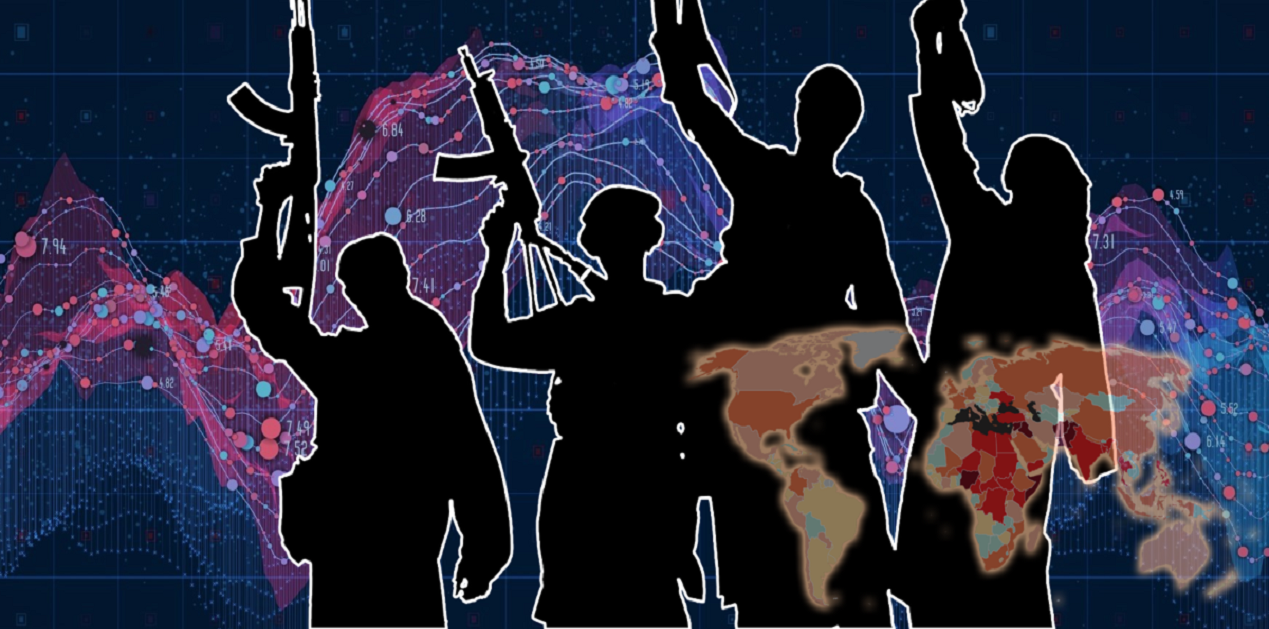





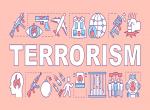
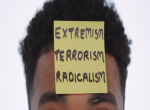


Post new comment